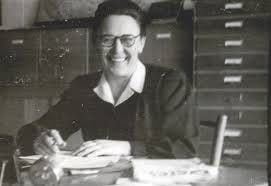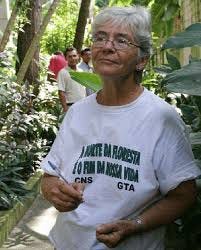Lessons from the Catholic Resistance
Turning to Our Forebears in a Moment of Historical Crisis
The wall next to my bed is cluttered with icons and images of my greatest heroes. Dorothy Day. Ignacio Ellacuría. Óscar Romero. What unites them is their courage. What continually draws me to them is their determination to resist oppression and dehumanization, their willingness to stand up against political regimes that threaten the lives and dignity of any member of the human family.
We find ourselves, only a few weeks into a new administration, wanting for such courage and determination, as a constitutional crisis unfolds like a poisonous flower studded with thorns: the slashing of aid to the poorest and most vulnerable, the reckless and illegal plan to simply displace all of Gaza’s citizens and turn the land into a resort, the freezing of funds lawfully advocated by Congress for life-saving research, the cruel mass deportations already underway, the offer to take in white South Africans as refugees from land reforms intended to address the injustices of apartheid (and offer which, thankfully, South Africa refused). Even Pope Francis has publicly and firmly rebuked this administration, and in particular, JD Vance’s ill-formed conceptions of Christian love and responsibility.
And that’s to say nothing of the frightening, and entirely recognizable, authoritarian playbook from which Trump and his ludicrously unqualified cabinet members are drawing: rolling back protections of all but straight white Christian citizens, removing representatives of the free press from the Pentagon, closing down offices designed to protect consumers, summarily firing over a dozen inspectors general, and pardoning allies, among them over 1,500 perpetrators of the violent January 6th riot.
I cannot include a complete list of the alarming actions taken by this administration; it would take far more words than I have at my disposal. (I started writing this essay a week ago, and it already feels woefully out of date; since then, Elon Musk’s malevolent grip on control has only tightened, allegiance to Putin’s dictatorship has strengthened, and 275,000 necessary federal employees have been unjustly fired, without cause. Thankfully, the New York Times is keeping a running list of the major actions and statements of this administration. It is helpful and horrifying.)
My fellow Catholics, we have seen this film before. It does not end well. In November 2024, 56% of American Catholic voters cast their votes for Trump. In the months since, I have spoken to many who, like myself, very emphatically did NOT; they feel alone, abandoned, and betrayed by their parishes, their communities, and their Church. In processing my own grief and steeling my determination to resist this administration and its dangerous, dehumanizing tactics, I turned first to a familiar place: the wall beside my bed.
There is a very long history of the Catholic Church entangling itself with power, prestige, and wealth, going all the way back to the Roman Empire. But there is an equally long tradition of Catholic resistance. This is the deep well from which I draw my daily strength.
I turn to St. Óscar Romero, Blessed Rutilio Grande, Ignacio Ellacuría, and many others who resisted the violent oppression of El Salvador’s death squads and military dictatorship, along with the Church’s complicity in it, at the cost of their own lives.
I think of Blessed Sára Salkaházi, who courageously hid Jews in her convent in Hungary, and of conscientious objector Franz Jägerstätter. I think of St. Maximilan Kolbe, who published an anti-Nazi newspaper before giving his life in exchange for another’s at Auschwitz. I think of Jesuit priest Alfred Delp, who advised the resistance against Hitler on Catholic social teaching in order to plan for a post-Nazi society and paid for it with his life.
I owe a debt of gratitude to Catholic laywoman Diane Nash, who led sit-ins during the Civil Rights movement and to Sister Mary Antona Ebo, a tireless Civil Rights activist. I look to Notre Dame president Fr. Ted Hesburgh, who linked arms with Dr. Martin Luther King, Jr.
I am drawn to Dorothy Day, who cut her teeth demonstrating for women’s suffrage and went on to protest air-raid drills, the unjust treatment of farm workers, and the general grind of a capitalism that crushed the poor in its mighty gears. I turn to Jesuit priest and poet Dan Berrigan, who burned draft cards in protest of the Vietnam War, and to artist Corita Kent, who voiced her dissent in bright and bold serigraphs.
I think of Sister Dorothy Stang, an outspoken critic of Brazilian oppression of the poor and destruction the environment, who was assassinated just twenty years ago for her work on behalf of her people.
I cannot include a complete list of the courageous and faith-inspired determination shown by the long procession of both saints and laypeople of the Catholic resistance; it would take far more words than I have at my disposal. Perhaps the most beautiful part of this holy parade is that there are so many ordinary people in its ranks whose names we will never know. (And, of course, I am inspired by resisters of all faith traditions or none; it just felt very important in this moment to speak to my own tradition, the one I was born into, left, and returned to as an adult on my own terms.)
Last week I asked on Instagram, “Who are your heroes of the Catholic resistance?” I could not keep up with the replies. Most of the names were familiar to me, but some were new. Our collective conversation encouraged me more than anything has in these past few weeks. (That conversation is now saved as a highlight marked “Resistance.”)
All of these people, the stars in the large constellation of Catholic resistance, were led by their faith not to seek power or personal safety, but to do instead what Jesus called the highest form of love: to lay down their lives for their fellow human beings. There is a bright and enduring torch that they bear. And we can be the next to carry it.
Mr. Rogers, beloved children’s television creator, said that his mother taught him, in times of disaster, to look for the helpers. As I consider what it means to an American Catholic in 2025, I would add that we should also look for the resisters. They are present in our rich history. And they are in action now, all around us, whether in committed communities of religious sisters, courageous clergy speaking out against injustice, or even the parishioners right next to us in the pews, refusing to cede their faith to those who would use it as a tool to dehumanize others.
And isn’t that what the communion of saints is for—both the canonized and the living body of Christ on earth—to walk alongside us and to assure us that we are not alone?
¡Adelante!
Cameron









Thank you Cameron for this! I've been thinking the same thing, but you have described the Catholic Resistance with much more precision and eloquence than I can muster now. I'm having a hard time tearing my eyes away from the train wreck that is/was our democracy.
I had not considered that it is a form of resistance to "refuse to cede" our faith "to those who would use it as a tool to dehumanize others."
I'm so grateful for your prayerful spirit and willingness to speak the truth in love.
May I add to your list, Dr. Paul Farmer, co-founder of Partners in Health. He was inspired by liberation theology to work to form healthcare systems that give a preferential option for the poor.